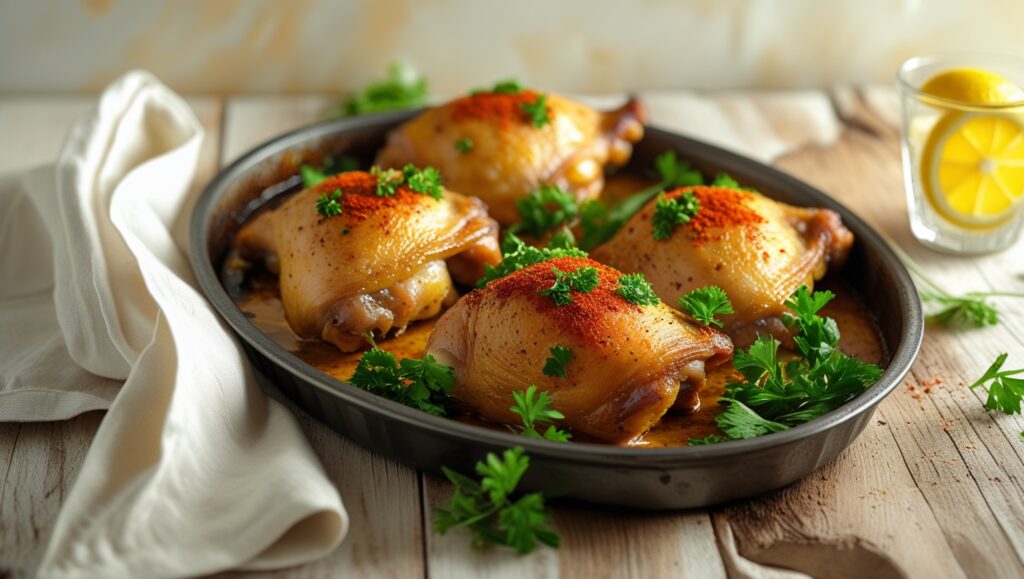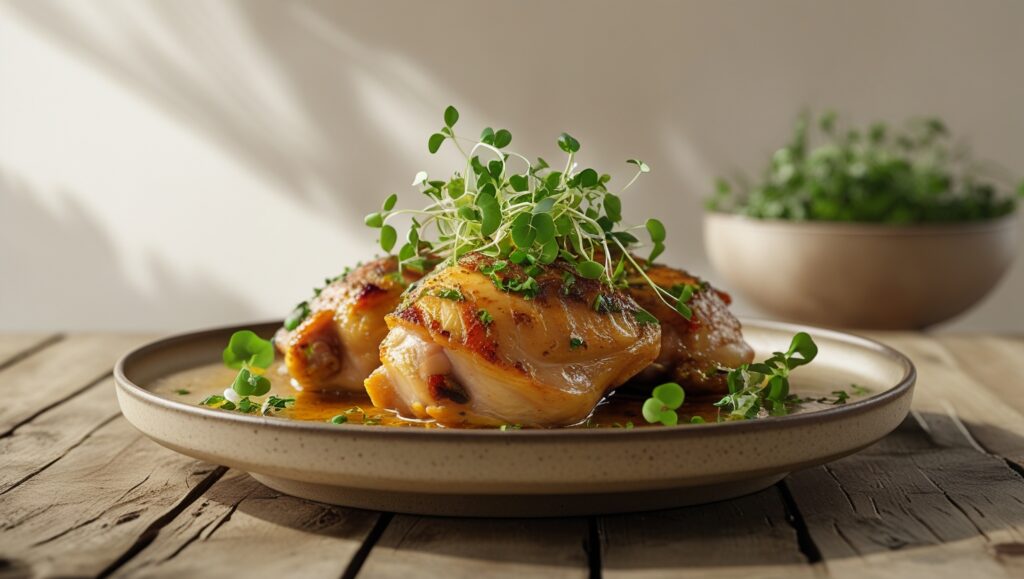Ingredients Baked Boneless Chicken Thighs
For the Perfect Baked Boneless Chicken Thighs:
- 8 boneless, skinless chicken thighs (approximately 2-3 lbs) – Choose thighs with even thickness for uniform cooking
- 2 tablespoons olive oil – Extra virgin preferred for enhanced flavor depth
- 1 teaspoon garlic powder – Fresh minced garlic can substitute (3 cloves)
- 1 teaspoon onion powder – Adds savory complexity without overwhelming
- 1 teaspoon paprika – Sweet or smoked varieties both work beautifully
- 1 teaspoon dried thyme – Fresh thyme can substitute (1 tablespoon)
- 1 teaspoon salt – Sea salt or kosher salt recommended
- ½ teaspoon black pepper – Freshly ground for optimal flavor
- ½ teaspoon dried rosemary – Crushed between fingers to release oils
- ¼ teaspoon cayenne pepper – Optional, for subtle heat
Smart Substitutions:
- Oil alternatives: Avocado oil, melted butter, or coconut oil
- Herb variations: Italian seasoning blend, herbs de Provence, or curry powder
- Heat adjustments: Red pepper flakes instead of cayenne, or omit entirely
- Salt options: Seasoned salt or herb salt for additional flavor complexity
Timing
Total Time Breakdown:
- Preparation Time: 10 minutes
- Marinating Time: 30 minutes (optional but recommended)
- Cooking Time: 25-30 minutes
- Resting Time: 5 minutes
- Total Time: 70-75 minutes
This efficient timeline represents approximately 25% less time than traditional bone-in chicken thigh recipes, making it perfect for busy weeknight dinners. The streamlined preparation process allows you to have a complete, restaurant-quality meal ready in just over an hour, with most of that time being hands-off cooking.
Step-by-Step Instructions
Step 1: Prepare and Season the Chicken Thighs
Begin by patting your boneless chicken thighs completely dry with paper towels—this crucial step ensures proper seasoning adherence and promotes beautiful browning. Trim any excess fat, leaving just enough to maintain moisture during cooking. In a large mixing bowl, combine all dry seasonings: garlic powder, onion powder, paprika, thyme, salt, pepper, rosemary, and cayenne. Drizzle the olive oil over the chicken thighs, then massage the seasoning blend evenly across each piece, ensuring complete coverage for maximum flavor penetration.
Step 2: Marinate for Enhanced Flavor (Optional)
While not mandatory, allowing your seasoned baked boneless chicken thighs to marinate for 30 minutes at room temperature significantly enhances flavor development. This brief marinating period allows the spices to penetrate the meat fibers while the chicken reaches closer to room temperature, promoting more even cooking. For deeper flavor infusion, refrigerate for up to 4 hours, bringing the thighs to room temperature 20 minutes before cooking.
Step 3: Preheat and Prepare Your Oven
Preheat your oven to 425°F (220°C), positioning the rack in the center for optimal heat circulation. Line a rimmed baking sheet with parchment paper or lightly grease with cooking spray. This higher temperature creates the perfect environment for achieving crispy exteriors while maintaining juicy interiors—the hallmark of exceptional baked boneless chicken thighs.
Step 4: Arrange for Even Cooking
Place the seasoned chicken thighs on your prepared baking sheet, ensuring at least 1 inch of space between each piece. This spacing allows hot air to circulate freely, promoting even cooking and preventing steaming. Arrange thighs with the smoother side facing up for the most attractive presentation.
Step 5: Bake to Perfection
Slide the baking sheet into your preheated oven and bake for 20-25 minutes, depending on thickness. The key to perfect baked boneless chicken thighs lies in monitoring internal temperature rather than relying solely on time. Use a meat thermometer to check the thickest part of each thigh—they’re done when the internal temperature reaches 165°F (74°C).
Step 6: Rest for Optimal Juiciness
Remove the chicken from the oven and let rest for 5 minutes before slicing or serving. This resting period allows the juices to redistribute throughout the meat, ensuring every bite remains moist and flavorful. Resist the temptation to cut immediately—patience here makes all the difference.
Step 7: Serve and Enjoy
Your perfectly baked boneless chicken thighs are now ready to serve. The exterior should be golden brown with a slight crisp, while the interior remains tender and juicy. Slice against the grain for the most tender texture, and serve immediately while hot.

Nutritional Information
Per Serving (1 chicken thigh, approximately 4 oz):
- Calories: 185
- Protein: 24g (48% of daily value)
- Fat: 9g (14% of daily value)
- Saturated Fat: 2.5g (13% of daily value)
- Carbohydrates: 1g
- Fiber: 0g
- Sugar: 0g
- Sodium: 310mg (13% of daily value)
- Cholesterol: 95mg (32% of daily value)
- Iron: 1.2mg (7% of daily value)
- Potassium: 285mg (8% of daily value)
Nutritional Highlights: Chicken thighs provide complete protein with all essential amino acids, supporting muscle maintenance and growth. They’re naturally rich in selenium, phosphorus, and B vitamins, particularly niacin and B6, which support energy metabolism and nervous system function. The moderate fat content includes beneficial monounsaturated fats that aid in nutrient absorption.
Healthier Alternatives for the Recipe
Reduce Sodium Options: Replace regular salt with herb blends, lemon zest, or salt-free seasoning mixes. Fresh herbs like basil, cilantro, or parsley add vibrant flavor without additional sodium.
Lower Fat Variations:
- Remove skin if using skin-on thighs for a 30% reduction in calories
- Use cooking spray instead of oil for coating
- Choose organic, free-range chicken for better omega-3 fatty acid profiles
Nutrient-Dense Additions:
- Add turmeric for anti-inflammatory benefits
- Incorporate nutritional yeast for B vitamins and umami flavor
- Use fresh ginger and garlic for immune-supporting compounds
Dietary Adaptations:
- Keto-friendly: Increase fat content with avocado oil or butter
- Paleo-compliant: Already fits perfectly with whole30 guidelines
- Anti-inflammatory: Add fresh rosemary, thyme, and ginger
Serving Suggestions
Classic Comfort Combinations: Pair your baked boneless chicken thighs with roasted vegetables like Brussels sprouts, carrots, and sweet potatoes for a complete, colorful meal. The chicken’s rich flavor complements both starchy and fibrous vegetables beautifully.
International Inspirations:
- Mediterranean Style: Serve over quinoa with cucumber, tomatoes, and tzatziki sauce
- Asian Fusion: Slice and serve over steamed rice with stir-fried vegetables and sesame seeds
- Mexican Flair: Dice for tacos with avocado, cilantro, and lime
- Southern Comfort: Alongside creamy mashed potatoes and green beans
Light and Fresh Options: Create vibrant salads by slicing the chicken over mixed greens, adding seasonal fruits like berries or stone fruits, nuts, and light vinaigrettes. The protein pairs excellently with grain bowls featuring farro, bulgur, or brown rice.
Make-Ahead Meal Ideas: These baked boneless chicken thighs excel in meal prep scenarios. Slice and portion with roasted vegetables and grains for grab-and-go lunches, or shred for quick addition to soups, pasta dishes, or sandwiches throughout the week.
Common Mistakes to Avoid
Temperature Misjudgments: The most frequent error involves cooking at too low temperatures, resulting in rubbery texture. Research shows that 425°F provides the optimal balance for achieving crispy exteriors and tender interiors in boneless thighs.
Overcrowding the Pan: Placing thighs too close together creates steam pockets, preventing proper browning. Maintain at least 1 inch between pieces for professional results.
Skipping the Rest Period: Cutting immediately after cooking releases precious juices. Studies indicate that a 5-minute rest period retains up to 15% more moisture compared to immediate slicing.
Inconsistent Thickness: Failing to pound thighs to even thickness results in uneven cooking. Thicker portions may remain undercooked while thinner areas become dry.
Over-seasoning or Under-seasoning: Balance is key—use approximately 1 teaspoon of total seasoning per pound of chicken. Taste-test your seasoning blend before applying to ensure optimal flavor without overwhelming the natural chicken taste.
Storing Tips for the Recipe
Refrigerator Storage: Store cooked baked boneless chicken thighs in airtight containers for up to 4 days in the refrigerator. Allow chicken to cool completely before storing to prevent condensation and maintain texture.
Freezer Storage: Properly wrapped chicken thighs maintain quality for up to 3 months in the freezer. Wrap individual portions in plastic wrap, then place in freezer bags for easy thawing and portion control.
Reheating Guidelines:
- Oven method: Reheat at 350°F for 10-15 minutes, covered with foil to prevent drying
- Microwave method: Use 50% power in 30-second intervals, checking frequently
- Stovetop method: Slice and warm in a covered skillet with a splash of broth
Meal Prep Strategies: Cook double batches and freeze half for quick future meals. Portion into individual containers with sides for complete grab-and-go meals. Label with dates and reheating instructions for family members.
Conclusion
Mastering baked boneless chicken thighs transforms your weeknight dinner routine with minimal effort and maximum flavor. This foolproof seven-step method delivers consistently juicy, perfectly seasoned chicken that rivals restaurant quality. The versatile nature of this preparation method accommodates various flavor profiles and dietary needs while maintaining exceptional nutritional value and budget-friendly appeal.
Ready to revolutionize your chicken game? Try this recipe tonight and discover why baked boneless chicken thighs deserve a permanent place in your dinner rotation. Share your results in the comments below, leave a review to help fellow home cooks, and subscribe for more tested recipes and cooking techniques that make everyday meals extraordinary!
FAQs
Q: Can I use bone-in chicken thighs instead of boneless? A: Absolutely! Bone-in thighs require approximately 10-15 additional minutes of cooking time. Check that internal temperature reaches 165°F near the bone for food safety.
Q: How do I know when my baked boneless chicken thighs are done without a thermometer? A: Pierce the thickest part with a knife—juices should run clear, not pink. The meat should feel firm but not hard when pressed gently.
Q: Can I prepare this recipe with frozen chicken thighs? A: Yes, but thaw completely first. Cooking from frozen results in uneven cooking and food safety concerns. Thaw overnight in the refrigerator for best results.
Q: What’s the best way to ensure crispy skin if I use skin-on thighs? A: Pat skin completely dry, season well, and place skin-side up. For extra crispiness, broil for the final 2-3 minutes of cooking.
Q: How can I adapt this recipe for meal prep? A: Cook as directed, then portion into containers with complementary sides. These keep well for 4 days refrigerated and reheat beautifully using the methods outlined in the storing section.
Q: Can I marinate these chicken thighs overnight? A: Yes! Overnight marination (up to 24 hours) creates even more flavorful results. Just bring to room temperature 20 minutes before cooking for even heat distribution.

